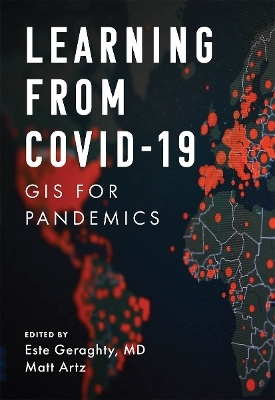
Learning from COVID-19
GIS for Pandemics
Seiten
2022
Environmental Systems Research Institute Inc.,U.S. (Verlag)
978-1-58948-711-6 (ISBN)
Environmental Systems Research Institute Inc.,U.S. (Verlag)
978-1-58948-711-6 (ISBN)
Learning from COVID-19: GIS for Pandemics explores a collection of real-life case studies about how organizations across the globe have successfully used GIS to respond to the COVID-19 pandemic.
Now that the health community is in a state of reflection, how do we put the lessons learned into practice?
As we step back to examine the worldwide response to the COVID-19 pandemic, now is the time to think about how to raise the bar for our response to the next public health emergency. Now is the time to revisit health preparedness strategies and plans. And now is the time to review what the health community did that worked—and how we can do that again.
Learning from COVID-19: GIS for Pandemics tells real-life stories about how spatial thinking became invaluable in both local and full-scale outbreaks during the COVID-19 pandemic.
Needing to answer the question of “where” sat at the forefront of everyone’s mind, and using a geographic information system (GIS) for real-time surveillance transformed possibly overwhelming data into location intelligence that provided agencies and civic leaders with valuable insights.
Co-edited by Esri chief medical officer Dr. Este Geraghty, this book highlights best practices, key GIS capabilities, and lessons learned during the COVID-19 response that can help communities prepare for the next crisis. GIS has empowered:
Organizations to use human mobility data to estimate the adherence to social distancing guidelines
Communities to monitor their health care systems’ capacity through spatially enabled surge tools
Governments to use location-allocation methods to site new resources (i.e., testing sites and augmented care sites) in ways that account for at-risk and vulnerable populations
Communities to use maps and spatial analysis to review case trends at local levels to support reopening of economies
Organizations to think spatially as they consider “back-to-the-workplace” plans that account for physical distancing and employee safety needs
Learning from COVID-19 also includes a “next steps” section that provides ideas, strategies, tools, and actions to help jump-start your own use of GIS, either as a citizen scientist or a health professional. A collection of online resources, including additional stories, videos, new ideas and concepts, and downloadable tools and content, complements this book.
Now is the time to use science and data to make informed decisions for our future, and this book shows us how we can do it.
Now that the health community is in a state of reflection, how do we put the lessons learned into practice?
As we step back to examine the worldwide response to the COVID-19 pandemic, now is the time to think about how to raise the bar for our response to the next public health emergency. Now is the time to revisit health preparedness strategies and plans. And now is the time to review what the health community did that worked—and how we can do that again.
Learning from COVID-19: GIS for Pandemics tells real-life stories about how spatial thinking became invaluable in both local and full-scale outbreaks during the COVID-19 pandemic.
Needing to answer the question of “where” sat at the forefront of everyone’s mind, and using a geographic information system (GIS) for real-time surveillance transformed possibly overwhelming data into location intelligence that provided agencies and civic leaders with valuable insights.
Co-edited by Esri chief medical officer Dr. Este Geraghty, this book highlights best practices, key GIS capabilities, and lessons learned during the COVID-19 response that can help communities prepare for the next crisis. GIS has empowered:
Organizations to use human mobility data to estimate the adherence to social distancing guidelines
Communities to monitor their health care systems’ capacity through spatially enabled surge tools
Governments to use location-allocation methods to site new resources (i.e., testing sites and augmented care sites) in ways that account for at-risk and vulnerable populations
Communities to use maps and spatial analysis to review case trends at local levels to support reopening of economies
Organizations to think spatially as they consider “back-to-the-workplace” plans that account for physical distancing and employee safety needs
Learning from COVID-19 also includes a “next steps” section that provides ideas, strategies, tools, and actions to help jump-start your own use of GIS, either as a citizen scientist or a health professional. A collection of online resources, including additional stories, videos, new ideas and concepts, and downloadable tools and content, complements this book.
Now is the time to use science and data to make informed decisions for our future, and this book shows us how we can do it.
Dr. Este Geraghty is the Chief Medical Officer and Health Solutions Director at Esri where she leads business development for the Health and Human Services sector. Matt Artz is a content strategist for Esri Press. He brings a wide breadth of experience in environmental science, technology, and marketing.
Introduction
How to use this book
Part 1: Situational awareness
Part 2: Equitable resource allocation
Part 3: Capacity and infrastructure
Part 4: Communication and engagement
Part 5: Recovery and resilience
COVID-19: Our lessons learned
Next steps
Contributors
| Erscheinungsdatum | 03.10.2022 |
|---|---|
| Reihe/Serie | Applying GIS |
| Zusatzinfo | Illustrations |
| Verlagsort | Redlands |
| Sprache | englisch |
| Maße | 139 x 203 mm |
| Gewicht | 317 g |
| Themenwelt | Studium ► 2. Studienabschnitt (Klinik) ► Rechtsmedizin |
| Studium ► Querschnittsbereiche ► Epidemiologie / Med. Biometrie | |
| Studium ► Querschnittsbereiche ► Infektiologie / Immunologie | |
| Naturwissenschaften ► Geowissenschaften ► Geografie / Kartografie | |
| ISBN-10 | 1-58948-711-7 / 1589487117 |
| ISBN-13 | 978-1-58948-711-6 / 9781589487116 |
| Zustand | Neuware |
| Informationen gemäß Produktsicherheitsverordnung (GPSR) | |
| Haben Sie eine Frage zum Produkt? |
Mehr entdecken
aus dem Bereich
aus dem Bereich
Befunderhebung, Rekonstruktion, Begutachtung
Buch | Hardcover (2024)
Springer (Verlag)
199,99 €


